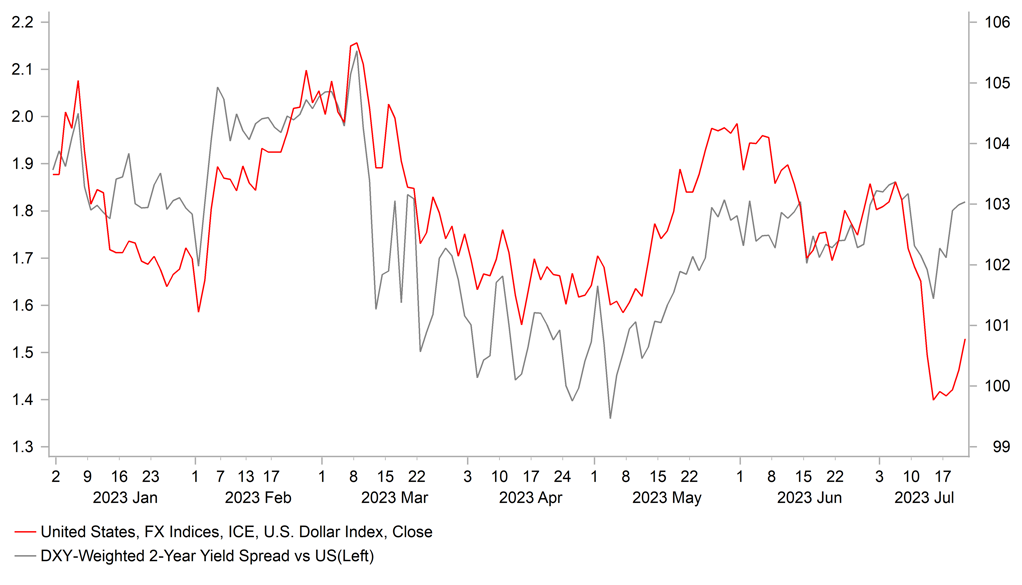Reversal of USD sell-off ahead of central bank updates next week
USD: US economy continues to show resilience as inflation pressures slow
The US dollar has continued to trade at stronger levels overnight after staging a strong rebound yesterday. The dollar index rose to an intra-day high yesterday of 100.97 as it moved further above last week’s low of 99.578. It has resulted in USD/JPY climbing back above the 140.00-level. The reversal of US dollar weakness from last week has been supported by the pick-up in US yields. The 2-year US Treasury bond yield has risen by just over 20bps since last week’s low. It mainly reflects US rate market participants scaling back expectations for how much the Fed is likely to cut rates next year while there has been little change to expectations for the Fed to deliver one final hike this month. The implied yield on the December 2024 Fed Fund futures contract has increased by around 30bps since the recent low from 13th July to around 4.09%. Even after the adjustment higher over the past week, the US rate market is still expecting the Fed to cut rates by over 100bps next year to lower the policy rate to less restrictive levels. Those expectations for Fed rate cuts next year are proving sensitive to incoming economic data at the current juncture as market participants anticipate that we are approaching a turning point for Fed policy.
The move higher in US yields yesterday was supported by the release of further economic data showing that the US economy is continuing to prove more resilient than expected to higher rates. The drop in initial claims over the past month is helping to ease fears that the US labour market could begin slow more sharply during the 2H of this year. It continues the run of stronger than expected US economic data releases this month. According to Bloomberg, it has been the strongest run of positive US economic data surprises since in early 2021. The Atlanta Fed’s GDPNow Forecast has risen recently up to 2.4% which is defying prior expectations for the US economy to have expanded well below potential through the 1H of this year. It poses upside risks to Bloomberg’s current consensus forecast for GDP growth in Q2 of 1.3%.
However, the recent run of stronger US activity data has not prevented the US dollar from falling to fresh year to date lows this month. Building evidence of slowing inflation in the US has been more important for driving the US dollar weaker. Slowing inflation should give the Fed more confidence that rates are now sufficiently restrictive, and if inflation continues to fall closer to the Fed’s inflation target it will begin to open up room for the Fed to being to lower rates next year. The combination of lower US rates in response to slowing US inflation and a softer landing for the US economy should be an unfavourable mix for US dollar performance.
WEAKER USD IS NOT FULLY BACKED BY RECENT MOVE IN YIELD SPREADS

Source: Bloomberg, Macrobond & MUFG GMR
JPY: Japan CPI in focus ahead of next week’s BoJ policy meeting
The main economic data release overnight was the latest CPI report from Japan for June. It comes just ahead of next week’s BoJ policy update. As we highlighted above the yen has been re-weakening this week ahead of the BoJ’s latest policy update which has helped lift USD/JPY back above the 140.00-level. The move higher in USD/JPY has been driven in part by the broad-based rebound for the US dollar and pick-up in US yields, but also by yen specific weakness triggered by comments (click here) earlier this week from BoJ Governor Ueda that have dampened expectations for a further shift in YCC policy settings as soon as at next week’s policy meeting.
The release overnight of the latest CPI report from Japan is unlikely to significantly alter market expectations for BoJ policy action ahead of next week’s policy meeting. The report revealed that both headline and Japan-style core inflation strengthened slightly over the previous month with both rising to annual rates of 3.3% in June. After stripping out energy as well which better reflects the balance between domestic supply and demand, the BoJ core inflation measure remained elevated at 4.2%. Inflation is expected to slow through the rest of this year as the disinflationary impact from lower energy and food prices begins to become more evident. The BoJ would come under more pressure to tighten policy if the inflation proves more sticky than expected on the way down and evidence continues to build of strengthening wage growth during 2H of this year. Our analysts in Tokyo are sticking their view that the BoJ will adjust YCC next week providing a trigger for the yen to strengthen, although it will take longer for the BoJ to bring an end to negative rates in Japan.
KEY RELEASES AND EVENTS
|
Country |
BST |
Indicator/Event |
Period |
Consensus |
Previous |
Mkt Moving |
|
CA |
13:30 |
Manufacturing Sales (MoM) |
-- |
-- |
1.2% |
!! |
|
CA |
13:30 |
New Housing Price Index (MoM) |
Jun |
0.0% |
0.1% |
!! |
|
CA |
13:30 |
Retail Sales (MoM) |
May |
0.5% |
1.1% |
!! |
Source: Bloomberg

